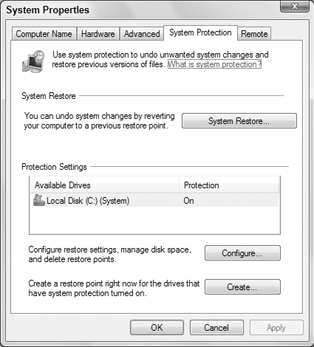System Protection is yet another means of
backing up important system files. Unlike either of the previous
methods, it doesn't require or use any external disks. Nor does it back
up any installed programs or all of Windows 7. Rather, it maintains
copies of the most important system files needed for Windows 7 to
operate properly, as well as hidden shadow copies of some of your own personal files.
The idea behind System Protection isn't to protect
you from rare catastrophic hard drive disasters; it's to protect you
from smaller and much more common mishaps. For example, you install
some program or device that wasn't really designed for Windows 7, on
the grounds that "It worked fine in XP so it should work fine here,"
only to discover that it doesn't work as well as you assumed it would
(because it wasn't designed for Windows 7). Even after uninstalling the
program, you find that some Windows 7 features don't work like they did
before you got the notion to give the old program or device a try.
Another common mishap is when you make some changes
to an important file, only they're not particularly good changes. But
you save the changes anyway out of habit, thereby losing the original
good copy of the file you started with. Sometimes System Protection can
even help you recover a file that you deleted and removed from the
Recycle Bin.
1. Turning System Protection on or off
System Protection is turned on by default for the
drive on which Windows 7 is installed. That means it's protecting your
Windows 7 operating system and also documents you keep in your user
account folders like Documents, Pictures, Music, and so forth.
If you have documents on other hard drives, you can
extend System Protection to protect documents on those drives, too.
However, it would be best not to try to use System Protection to
protect a hard drive that has another operating system installed on it,
like Windows XP. Windows XP has its own System Restore feature.
System Protection is an optional feature. You can
turn it on and off at will (providing you have administrative
privileges, because it affects all user accounts). And you can choose
for yourself which volumes it will
monitor. (A volume is any hard drive or hard drive partition that looks
like a hard drive in your Computer folder.) To get to the options for
controlling System Protection, first open your System folder using any
of the following techniques:
Click the Start button, right-click Computer, and choose Properties.
Click the Start button, type sys, and click System.
Click the Start button and choose Control Panel => System and Security => System.
In the left pane of your System folder, click System
Protection. The System Properties dialog box opens to the System
Protection tab as in Figure 1.
To ensure that system protection for Windows 7 and
user account files is turned on, first look in the Protection Settings
box to verify that the Protection column shows "On" for your system
disk (typically Drive C:). If the Protection column indicates that
protection is off, click the Configure button to open the System
Protection dialog box. Then, choose one of the first two settings in
the Restore Settings group. You can also specify how much disk space to
allocate to system protection with the Max Usage slider.
|
Note that if you turn off System Protection, all existing restore points are deleted.
|
|
If your computer contains other volumes, whether you
apply System Protection to them depends on what is on the volumes and
whether you find it worthwhile to enable system protection on them.
After you've made your selections, click OK. You're done. Nothing will happen immediately, but Windows 7 will create restore points every 24 hours. Each restore point contains copies of your important system files, and shadow copies of files on the volumes you specified.
System Protection needs a minimum of 300 MB of space
on each protected volume for restore points. If necessary it will use
from 3 to 5 percent of the total drive capacity. It won't grow
indefinitely or consume a significant amount of disk space. Instead it
will delete old restore points before creating new ones. Old restore
points are of dubious value anyway.
